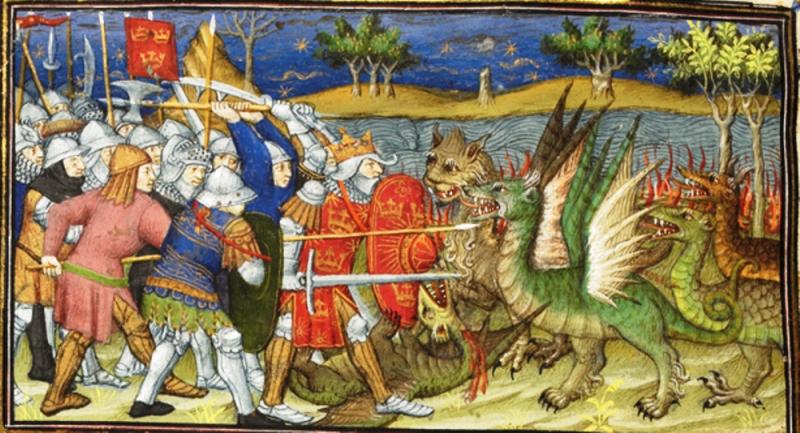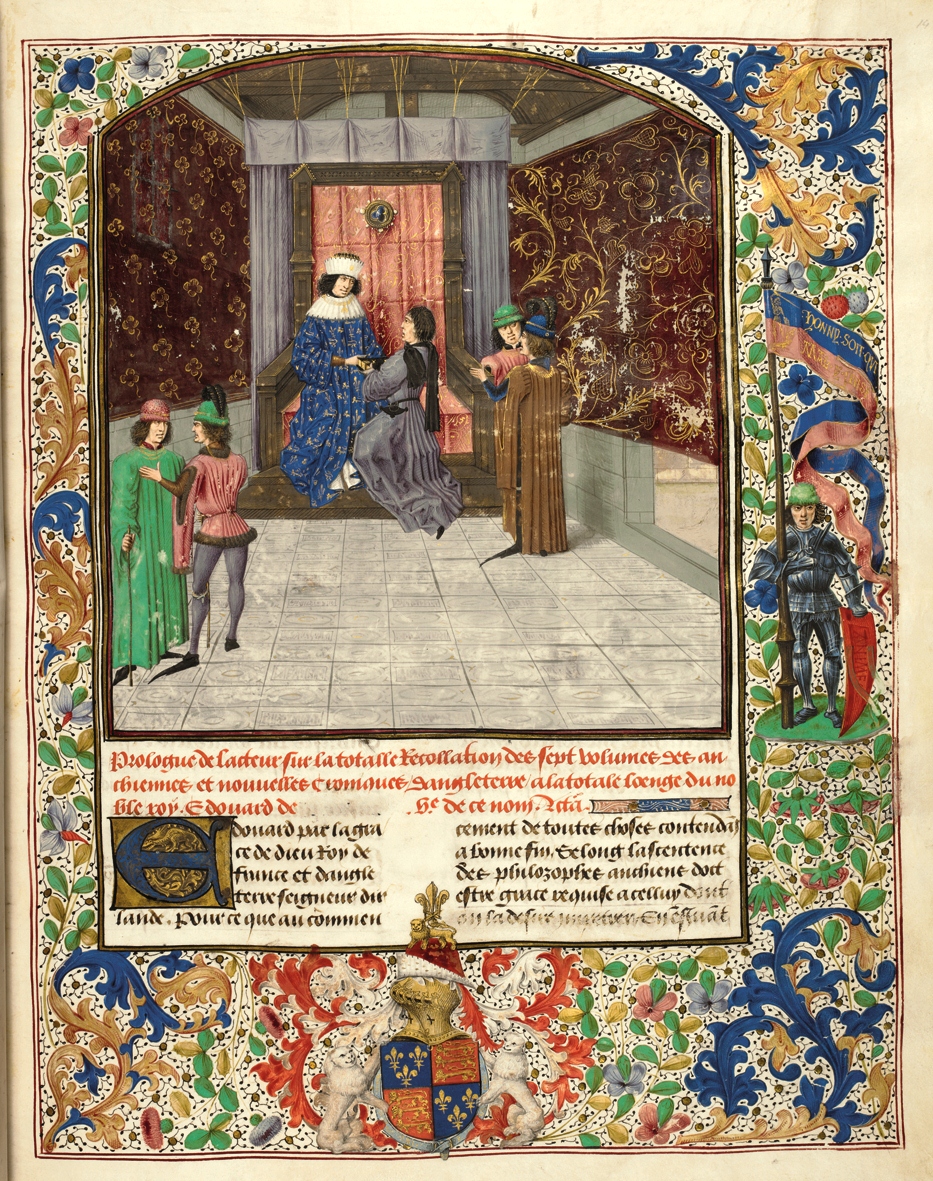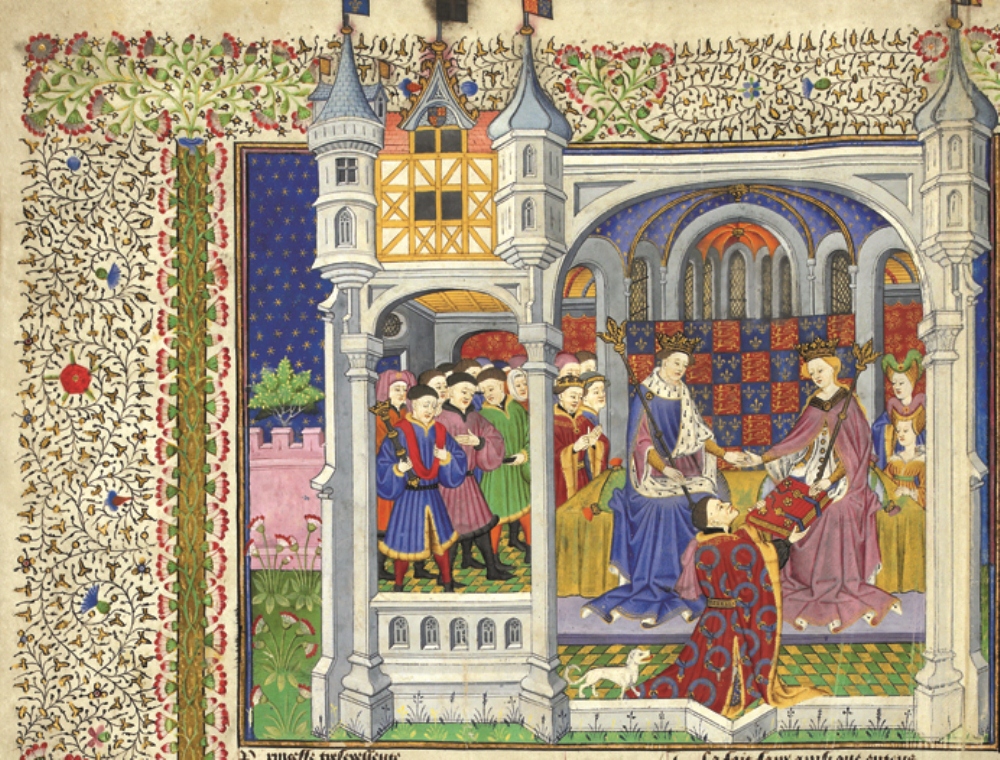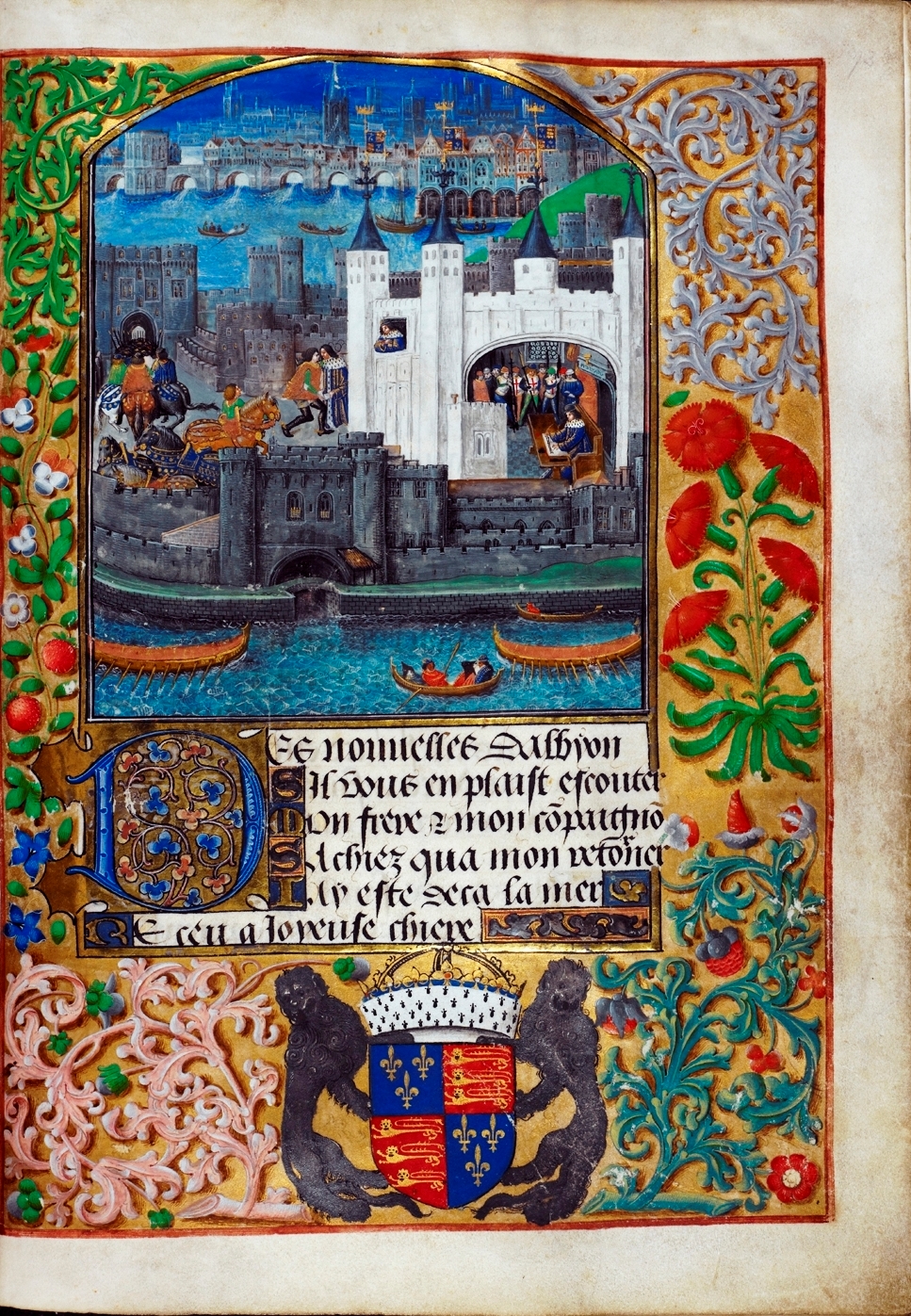Royal Manuscripts: The Genius of Illumination, British Library | reviews, news & interviews
Royal Manuscripts: The Genius of Illumination, British Library
Royal Manuscripts: The Genius of Illumination, British Library
A glittering display of treasures brings the world of medieval kings alive

In 1757, what had previously been the royal collection of manuscripts was handed over to the nascent British Museum. Edward IV, who started the collection in the 15th century, had created a collection of books designed to display the greater glory of God and (by extension) his chosen sovereigns and country: the Yorkist leader in the Wars of the Roses used these books, and the images they contained, to create a propaganda machine to suggest that God was on his side.
The illuminations he commissioned were from craftsmen of the first rank, and they cover not only history and religion, in chronicles and Bibles and psalters, but show revealing glimpses of courtly life of the period. The Treasury of History, a history chronicle, shows a tiny moated castle and surrounding lands (complete with duck paddling in the moat), and as such is one of the very earliest secular landscape images in Western art. Jean de Wavrin’s magnificent Chronicle of English History shows John of Gaunt dining in one drawing: not only a record of this great nobleman’s meeting with the King of Portugal, but also, for us, a record of how basic living conditions were even for the mighty – the grandees are eating off rather ordinary trenchers, and it is clear from the place settings that forks have yet to be in daily use. It also has wonderful details: beefy cooks serve up the food through a hatch, and a courtier in the corner plucks at his pointy shoes to make the tips stand up more. (Pictured below, from the same manuscript, the author presents his chronicle to Edward IV.)
 Some of the illustrations are more like paintings than illustrations. In a 1411 Bible Historiale, possibly commissioned by the same Duc de Berri whose Très riches heures is so famous, God creating the heavens and the earth shows a figure that is almost Renaissance-like in its stature. And this interweaving between the page and painting, although only a minor element of the show in terms of quantity, reverberates throughout. Seeing a portrait of Elizabeth I after George Gower (c 1600) in the context of manuscript illumination enables the modern viewer to “read” the pictorial surface patterns in a new way.
Some of the illustrations are more like paintings than illustrations. In a 1411 Bible Historiale, possibly commissioned by the same Duc de Berri whose Très riches heures is so famous, God creating the heavens and the earth shows a figure that is almost Renaissance-like in its stature. And this interweaving between the page and painting, although only a minor element of the show in terms of quantity, reverberates throughout. Seeing a portrait of Elizabeth I after George Gower (c 1600) in the context of manuscript illumination enables the modern viewer to “read” the pictorial surface patterns in a new way.
And although the close links between the rulers of France and England are well known historically, the dense mesh of inter-relationships is given visual reality by the sheer number of French manuscripts owned by English kings, or of depictions of English history that encompass French rulers and the ruled. The First Earl of Shrewsbury’s 1444-45 wedding present to Marguerite d’Anjou gives a joint French and English genealogy, as well as a picture of the presentation of the gift itself from Earl to Queen (detail, pictured below left).
 The exhibition is breathtaking in scope and scale, with manuscripts seeming to stretch away into infinity – Bibles, histories, psalters, bestiaries, tales of mythological heroes and classical history, maps of journeys to the Holy Land or books of Canon law, horoscopes, conduct books and more. Interspersed with these are computer screens which explain to viewers to stop and explore specific points of detail, or stylistic elements. The British Library has been at the forefront of excellent digital programming, and here it shows its skill once again.
The exhibition is breathtaking in scope and scale, with manuscripts seeming to stretch away into infinity – Bibles, histories, psalters, bestiaries, tales of mythological heroes and classical history, maps of journeys to the Holy Land or books of Canon law, horoscopes, conduct books and more. Interspersed with these are computer screens which explain to viewers to stop and explore specific points of detail, or stylistic elements. The British Library has been at the forefront of excellent digital programming, and here it shows its skill once again.
If there is a niggle it is that the exhibition is focused on the illustrations almost to the exclusion of history. Some of the captions are woolly. The one that says flatly that Edward IV’s "two young sons… died in the Tower of London after his death" is a woeful "princes in the Tower" rehash with no basis in historical certainty. (A later caption, more sensibly, adds the word "presumed".) Nearby, an account book recording how much Edward spent on his books is displayed, but there is no transcription of the information, even though details of what the illuminations cost, or what materials were used in the bindings, would be fascinating.
 A case in point is a book from 1492-1500, which includes illustrations of the imprisonment of Charles d’Orléans in the Tower of London. (He was captured at Agincourt in 1415, and held for more than a quarter of a century.) The book (pictured above), the caption says, also includes his poems, but we are given no examples, despite him writing some of the most beautiful verse of the time. (Le temps a laissé son manteau was set to music by many, including Debussy, and is famous enough that it returns nearly three-quarters of a million Google hits: citing it would not have been difficult.)
A case in point is a book from 1492-1500, which includes illustrations of the imprisonment of Charles d’Orléans in the Tower of London. (He was captured at Agincourt in 1415, and held for more than a quarter of a century.) The book (pictured above), the caption says, also includes his poems, but we are given no examples, despite him writing some of the most beautiful verse of the time. (Le temps a laissé son manteau was set to music by many, including Debussy, and is famous enough that it returns nearly three-quarters of a million Google hits: citing it would not have been difficult.)
Despite these lacks, the show is a window into a world that is all too rarely seen, these gorgeously illustrated books needing to be stored in the dark for preservation purposes. Royal Manuscripts will display 150-plus for four months. Everyone who can should hustle down to the British Library to have a look before they are wrapped up once more. A genuine treasure.
- Royal Manuscripts at the British Library until 13 March, 2012
- Smartphone and tablet apps
Explore topics
Share this article
The future of Arts Journalism
You can stop theartsdesk.com closing!
We urgently need financing to survive. Our fundraising drive has thus far raised £49,000 but we need to reach £100,000 or we will be forced to close. Please contribute here: https://gofund.me/c3f6033d
And if you can forward this information to anyone who might assist, we’d be grateful.

Subscribe to theartsdesk.com
Thank you for continuing to read our work on theartsdesk.com. For unlimited access to every article in its entirety, including our archive of more than 15,000 pieces, we're asking for £5 per month or £40 per year. We feel it's a very good deal, and hope you do too.
To take a subscription now simply click here.
And if you're looking for that extra gift for a friend or family member, why not treat them to a theartsdesk.com gift subscription?
more Visual arts
 'We are bowled over!' Thank you for your messages of love and support
Much-appreciated words of commendation from readers and the cultural community
'We are bowled over!' Thank you for your messages of love and support
Much-appreciated words of commendation from readers and the cultural community
 Lee Miller, Tate Britain review - an extraordinary career that remains an enigma
Fashion photographer, artist or war reporter; will the real Lee Miller please step forward?
Lee Miller, Tate Britain review - an extraordinary career that remains an enigma
Fashion photographer, artist or war reporter; will the real Lee Miller please step forward?
 Kerry James Marshall: The Histories, Royal Academy review - a triumphant celebration of blackness
Room after room of glorious paintings
Kerry James Marshall: The Histories, Royal Academy review - a triumphant celebration of blackness
Room after room of glorious paintings
 Folkestone Triennial 2025 - landscape, seascape, art lovers' escape
Locally rooted festival brings home many but not all global concerns
Folkestone Triennial 2025 - landscape, seascape, art lovers' escape
Locally rooted festival brings home many but not all global concerns
 Sir Brian Clarke (1953-2025) - a personal tribute
Remembering an artist with a gift for the transcendent
Sir Brian Clarke (1953-2025) - a personal tribute
Remembering an artist with a gift for the transcendent
 Emily Kam Kngwarray, Tate Modern review - glimpses of another world
Pictures that are an affirmation of belonging
Emily Kam Kngwarray, Tate Modern review - glimpses of another world
Pictures that are an affirmation of belonging
 Kiefer / Van Gogh, Royal Academy review - a pairing of opposites
Small scale intensity meets large scale melodrama
Kiefer / Van Gogh, Royal Academy review - a pairing of opposites
Small scale intensity meets large scale melodrama
 Jenny Saville: The Anatomy of Painting, National Portrait Gallery review - a protégé losing her way
A brilliant painter in search of a worthwhile subject
Jenny Saville: The Anatomy of Painting, National Portrait Gallery review - a protégé losing her way
A brilliant painter in search of a worthwhile subject
 Abstract Erotic, Courtauld Gallery review - sculpture that is sensuous, funny and subversive
Testing the boundaries of good taste, and winning
Abstract Erotic, Courtauld Gallery review - sculpture that is sensuous, funny and subversive
Testing the boundaries of good taste, and winning
 Edward Burra, Tate Britain review - watercolour made mainstream
Social satire with a nasty bite
Edward Burra, Tate Britain review - watercolour made mainstream
Social satire with a nasty bite
 Ithell Colquhoun, Tate Britain review - revelations of a weird and wonderful world
Emanations from the unconscious
Ithell Colquhoun, Tate Britain review - revelations of a weird and wonderful world
Emanations from the unconscious
 Rachel Jones: Gated Canyons, Dulwich Picture Gallery review - teeth with a real bite
Mouths have never looked so good
Rachel Jones: Gated Canyons, Dulwich Picture Gallery review - teeth with a real bite
Mouths have never looked so good

Add comment